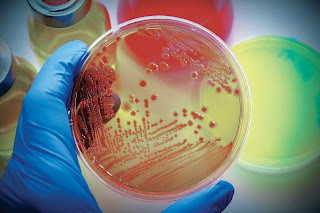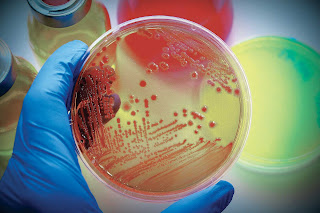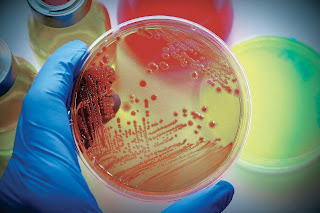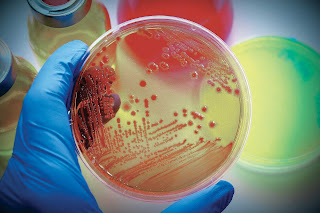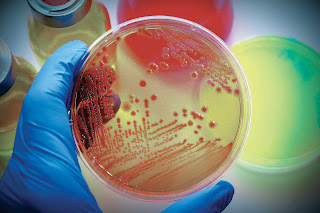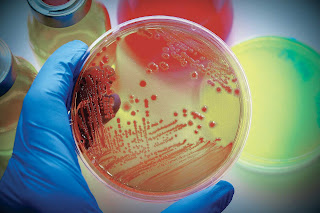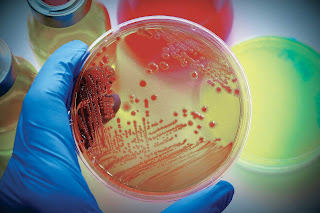Friday, 15 October 2021
Isolation and In Vitro Activities of Asplenum Bulbiferum Leaf Extracts on Bacteria Associated with Lung Diseases
Thursday, 14 October 2021
The In Vivo Effects of Asplenum Bulbiferum Ethanolic Leaf Extracts on Four Common Bacteria Associated with Lung Diseases
Monday, 11 October 2021
Nutritional and Proximate Assessment of Milk Blends Formulated from Tiger Nut and Soy Beans
Sunday, 3 October 2021
Phytotoxicity and Microbial Activities of Crude Oil Polluted Pristine Soil during Bioremediation with Saw Dust Amendment from Awka, Nigeria
Sunday, 26 September 2021
Medicinal Effects of Solanum Aethiopicum Leaf Ethanolic Extracts on Renal and Hepatic Function of Wistar Rats
Friday, 17 September 2021
Microbiological and Physico chemical Examination of Crude Oil Contaminated Soil from Awka Anambra State Nigeria
Crude oil is a complex mixture of aliphatic and aromatic hydrocarbons that causes a variety of risks when released into agricultural and aquatic environment. This oil can alter population dynamics and disrupt tropic integrations and the structure of natural communities within ecosystems during spills. Microbiological and Physico chemical properties of crude oil and pristine soil samples were assessed using standard procedures. Most frequently occurring microbial isolates obtained were identified using molecular typing. Bacteria isolated from the contaminated soil were Bacillus subtilis, Bacillus cereus, Bacillus thuringiensis, Pseudomonas fluorescens, Pseudomonas aeruginosa, Alcaligenes faecalis and Klebsiella pneumoniae. Fungi isolated were Penicillium citrinnum, Aspergillus fumigatus, Aspergillus flavus and Rhizopus stolonifer. The most frequently occurring novel isolates were S. maltophilia, P. sordelli, B. thuringensis, F. solani, C. deightonni, P. citrinnum, and C. bertholletiae. Percentage organic carbon content of the crude oil contaminated soil was 21.50 while the nitrogen content was 0.90 with a pH value of 4.69. This research showed that crude oil contamination of agricultural soil distorts its physico chemical parameters which has consequent toxicity on the soil, thus possibly hampering its fitness for use in crop production.
by Anagboso, M. O. | Orji, M. U. | Ikele, M. O. "Microbiological and Physico-chemical Examination of Crude Oil Contaminated Soil from Awka Anambra State Nigeria"
Published in International Journal of Trend in Scientific Research and Development (ijtsrd), ISSN: 2456-6470, Volume-5 | Issue-6 , October 2021,
Saturday, 4 September 2021
Evaluation of the Wort Properties of Four Improved Sorghum Varieties Mashed with and Without Commercial Enzyme
To determine the wort properties of recently improved sorghum properties, the malt of four sorghum varieties namely Samsorg 46, Samsorg 47, Samsorg 48 and Samsorg 49 were analyzed. The grains were malted and mashed with and without commercial enzyme, using the single decoction mashing technique. The wort derived from the mashing was filtered and boiled, then analyzed. The wort properties looked out for include, specific gravity, Protein estimation using Micro Kjeldahl method, reducing sugar using the DNS method and free a amino nitrogen FAN using method described by Association of Official Analytical Chemists, pH, filterability rate. Generally, there were significant differences across the different varieties of sorghum for, FAN, reducing sugars, cold water extract and hot water extract at both p 0.05 and p 0.01. There was a general increase in specific gravity, reducing sugar, FAN, filterability rate and pH, as the days of germination increased across the varieties, while there was a noticeable decrease in protein content as the days of germination increased in single decoction method of mashing. The varieties gave good results using single decoction method as there were increases in the specific gravity with Samsorg 47 having the highest with 100 malt wort 1.035 and malt enzyme wort 1.036 , reducing sugar with Samsorg 46 having the highest with 100 malt wort 130mg ml and malt enzyme wort 130mg ml , FAN with Samsorg 48 having the highest with 100 malt wort 284.69mg L and Samsorg 49 for malt enzyme wort 351.38mg L and filterability rate with Samsorg 47 having the highest with 100 malt wort 3.00ml min and malt enzyme wort 3.80ml min . The four recently improved sorghum varieties had good wort properties but more works need to be done on then to realize their full potential.
by Okoro, N. C. N. | Okonkwo, I. F. | Izundu, M. I "Evaluation of the Wort Properties of Four Improved Sorghum Varieties Mashed with and Without Commercial Enzyme"
Published in International Journal of Trend in Scientific Research and Development (ijtsrd), ISSN: 2456-6470, Volume-5 | Issue-6 , October 2021,
URL: https://www.ijtsrd.com/papers/ijtsrd46385.pdf
Tuesday, 24 August 2021
Isolation and Molecular Characterization of Pullulanase Producing Bacillus Strains
Pullulanase is an extracellular carbohydrase responsible for the hydrolysis of pullulan and amylopectin toproduce maltotriose. The product maltotriose is used in detergent industry, bakery industry and in the production of biotechnological products. In the present investigation pullulanase producing bacillus species were isolated and characterized using different biochemical and molecular methodologies. The isolates were identified as Bacillus cereus and Bacillus thuringiensis respectively.. The pullulanase acivity was higher in Bacillus cereus, 0.62U ml than B. thuringiensis, 0.53 U ml. This research reveals that pullulanase enzyme production from these Bacillus species shows great promise for use in industrial processes.
by Nwozor, N. C | Ogbo, F. C "Isolation and Molecular Characterization of Pullulanase Producing Bacillus Strains" Published in International Journal of Trend in Scientific Research and Development (ijtsrd), ISSN: 2456-6470, Volume-5 | Issue-5 , August 2021,
URL: https://www.ijtsrd.com/papers/ijtsrd45051.pdf
Monday, 23 August 2021
Isolation and Identification of Bacteria from Peeled and Ready to Eat Pineapple Ananas Comosus Fruits Retailed at Eke Awka Market, Anambra State, Nigeria
Pineapple Ananas comosus is an indispensible fruit that is cherished by many people due to its huge health benefits. It is peeled and sold in many markets and road sides for easy accessibility. The presence of bacteria in the peeled and ready to eat fruits was checked in this study. Peeled, sliced and cellophane packaged pineapple fruits were purchased from Eke Awka Market in Anambra State Nigeria. Nutrient agar was used to carry out bacterial isolation using pour plate technique. Results showed that colony count of the pineapple fruits ranged from 3.5 9.5 2cfu ml of the rinsed water. The isolates were identified on the basis of their colony and morphological features as well as biochemical and sugar fermentation tests. Gene sequencing was used to confirm the species of some of the isolates. A total of six bacteria species were isolated and identified with frequencies as Streptococcus spp 13.9 , Pseudomonas aeruginosa 22.2 , Staphylococcus aureus 25.0 , Micrococcus luteus 11.1 , Escherichia coli 19.5 and Staphylococcus epidermidis 8.3 . Staphylococcus aureus has the highest frequency followed by Pseudomonas aeruginosa. Staphylococcus epidermidis has the least frequency. Almost all the isolates are pathogenic in nature and their presence in the consumable fruits indicates possible health problems to the consumers. The presence of E. coli indicates direct or indirect fecal contamination. Proper handling of pineapple fruits, hygiene and proper storage will help reduce the risk of contamination by these organisms.
by Umeh S. O. | Okafor O. I. | Chidubem-Nwachinemere, N. O "Isolation and Identification of Bacteria from Peeled and Ready to Eat Pineapple (Ananas Comosus) Fruits Retailed at Eke Awka Market, Anambra State, Nigeria" Published in International Journal of Trend in Scientific Research and Development (ijtsrd), ISSN: 2456-6470, Volume-5 | Issue-5 , August 2021,
URL: https://www.ijtsrd.com/papers/ijtsrd45050.pdf
Sunday, 22 August 2021
Biodegradation Potentials of Aspergillus Flavipes Isolated from Uburu and Okposi Salt Lakes
Saline lakes are water bodies with salinity greater than 3 g l 0.3 , while hypersaline lakes are water bodies that surpass the moderate 35 g l 3.5 salt of oceans. Hypersaline lakes, could either be thalassohaline which are creations of evaporation of seawater and as such contain sodium chloride as the major salt, with a salinity that surpasses that of seawater by a factor of 5 – 10, with a neutral or slightly alkaline pH . Whereas, athalassohaline lakes stem from non seawater sources and are made up of high concentrations of ions such as magnesium and calcium and sundry other ions such as potassium, or sodium in smaller amounts. This work has revealed the biodegradation potentials of some halophiles isolated from Uburu and Okposi salt lakes. The isolates recovered in descending order of salt tolerance were Aspergillus flavipes 13mm at 40 , Penicillium citrinum 10mm at 40 , Aspergillus ochraceus 9mm at 40 , Aspergillus nomius 15mm at 35 , Microsphaeropsis arundinis 12mm at 35 , Aspergillus sydowi 28mm at 30 , Penicillium janthinellum 26mm at 30 , Mucor sp 13mm at 30 , Aureobasidium sp 12mm at 30 , Trichoderma sp 9mm at 30 , Alternaria sp. 22mm at 25 , Aspergillus sp 18mm at 25 , Penicillium sp 20mm at 20 , Cladosporium sp. 7mm at 15 and identified using ITS rDNA Sequencing Macrogen, South Korea . They belonged to the borderline extreme halophiles and moderate halophiles respectively. The biodegradative potential of Aspergillus flavipes was ascertained by testing it against 2 , 4 and 6 crude oil and it grew only on 2 crude oil Bushnell Haas broth with a fungal count of 2.56x105 cfu ml. Crude oil degradation rate was evaluated biweekly gravimetrically with 22 degradation in 2 weeks, 36 in 4 weeks, 67 in 6 weeks and 89 in 8 weeks as well as by way of gas chromatography GC FID , which showed that fractions C10 C11 were significantly degraded, C12 C20, moderately degraded and C26 C34, insignificantly degraded.
by Kingsley C. Agu | Frederick J. C. Odibo "Biodegradation Potentials of Aspergillus Flavipes Isolated from Uburu and Okposi Salt Lakes" Published in International Journal of Trend in Scientific Research and Development (ijtsrd), ISSN: 2456-6470, Volume-5 | Issue-5 , August 2021,
URL: https://www.ijtsrd.com/papers/ijtsrd44949.pdf
internationaljournalsinengineering, callforpaperengineering, ugcapprovedengineeringjournal
Sunday, 15 August 2021
Cost effective Analysis of Different Soil Samples to Check their Potential for Producing Cellulose Degrading Bacteria
The present investigation was undertaken to isolate and screen the cellulase producing bacteria from soil. Cellulose is considered to be the most abundant carbohydrate on earth along with hemicelluloses and lignin, which constitutes the plant cell wall. Cellulolytic enzymes are the backbone of various industries including food, animal feed, brewing, wine, agricultural biomass refining, pulp, paper, textile and ethanol production. In this paper, cellulose degrading bacteria was isolated and screened from different soil samples from agriculture farm, waste dumping area and termite soil using Carboxymethyl cellulose CMC , wheat bran and waste paper plus nutrient agar as a selective medium. After screening, only five isolates KHU2, KHU8, KHU9, KHU13 and KHU14 were selected due to the maximum diameter of zone of substrate hydrolysis. The diameter of zone of substrate hydrolysis in NAM plates containing wheat bran for the isolates KHU2, KHU8, KHU9, KHU13 and KHU14 was 8±3mm, 21±2mm, 13±1mm, 12±1mm and 10±2mm, respectively, whereas the diameter of zone of substrate hydrolysis in NAM plates containing waste paper for the isolates KHU2, KHU8, KHU9, KHU13 and KHU14 was 13±1mm, 24±1mm, 17±1mm, 14±2mm and 15±1mm respectively. This was compared with the diameter of zone of substrate hydrolysis in NAM plates containing CMC cellulose was also measured for the isolates KHU2, KHU8, KHU9, KHU13 and KHU14 was 16±1mm, 25±1mm, 22±1mm, 19±2mm and 20±2mm. It was concluded that the diameter of zone of substrate hydrolysis on waste paper was nearly same as obtained with CMC cellulose and the highest diameter of zone of substrate hydrolysis was seen in isolate KHU8 25±1mm in NAM plates plus CMC cellulose from termite soil sample. So, termite soil has the maximum potential to produce cellulose degrading bacteria.
By Khushboo Pal | Anshika Sharma | Tanu Sharma | Dr. Divya Sharma "Cost-effective Analysis of Different Soil Samples to Check their Potential for Producing Cellulose Degrading Bacteria" Published in International Journal of Trend in Scientific Research and Development (ijtsrd), ISSN: 2456-6470, Volume-5 | Issue-5 , August 2021,
URL: https://www.ijtsrd.com/papers/ijtsrd43937.pdf
Monday, 9 August 2021
Investigation in the use of a Yeast Specie Isolated from a Fermented Beverage for Mixed Fruit Wine Production
The juice from well ripped pawpaw fruit Carica papaya and watermelon Citrullus lanatus were extracted, mixed and used to produce wine by fermentation using a yeast strain Saccharomyces cerevisiae isolated from a fermented local beverage drink “burukuutu-. The “must- and wine were analyzed daily during fermentation to determine the pH, specific gravity, titratable acidity and reducing sugar content. It was fermented at 30 for 12 days. The pH increased from 3-¢5 to 4-¢4, specific gravity decreased from 1-¢009 to 1-¢002 , reducing sugar content decreased from 0-¢11 to 0-¢00 g, while titratable acidity increased from 1-¢5 to 12-¢3 at the end of the fermentation. The alcoholic content of the wine increased to 3-¢96 after ageing while temperature was maintained at room temperature throughout the period of fermentation. The wine presented a brilliant yellow color with a slight sweet flavor. Sensory evaluation showed that the mixed juice of pawpaw and watermelon wine had slight potential when compared to other commercial samples p 0-¢05 . These results showed that mixed juice of pawpaw and watermelon can be successfully used in the production of table wine. Using the yeast from a cheap local source makes the wine affordable and available. Also utilizing these fruits in wine production will help to reduce post harvest losses incurred on these fruits.
Umeh, S. O. | Ikele, M. O. | Okeke, B. C. | Nwiyi, I. U. "Investigation in the use of a Yeast Specie Isolated from a Fermented Beverage for Mixed Fruit Wine Production" Published in International Journal of Trend in Scientific Research and Development (ijtsrd), ISSN: 2456-6470, Volume-5 | Issue-5 , August 2021,
URL: https://www.ijtsrd.com/papers/ijtsrd43890.pdf
internationaljournalsofcomputerscience, callforpapercomputerscience, ugcapprovedjournalsforcomputerscience
Cassava Retting Water An Alternative Source for Industrial Cellulase Enzyme
Cassava fermentation is one of the teaming businesses in almost all the tribes of Nigeria. Among all the methods of cassava processing to food, fermentation is the most used. This produces foul smelling waste water that causes environmental pollution to man and animals. The retted cassava water was checked for cellulase enzyme activity to see if it can be a source of cellulase for used in food, paper, textile and other industries. The aim of this work is to seek a way of utilizing the waste water as source of enzymes as this will reduce the importation of these enzymes and make them available always. Cassava tubers were peeled, cut into cylindrical portions of about 3 5 cm and washed. Two hundred grams of the washed tubers were soaked in 5 liters of water and allowed to ret. The retting water was analyzed daily for titratable acidity, cyanide content, pH, cellulase activity and the microbial flora were isolated and identified. Results showed that titratable acidity rose from 0.20 to 2.76 mg g and cyanide content increased from 0.28 to 4.69 mg ml while pH fall from 7.2 – 6.0 tending acidic. Retting started on the 2nd day and complete retting was achieved on the 4th day. ß glucosidase activity rose from 0.05 to 8.0 µ mol, Filter paper activity increased from 0.06 to 7.5 µ mol and carboxyl methyl cellulase CMC activity increased from 0.05 to 7.7 µ mol. Ten organisms Aspergillus fumigatus, Rhizopus stolonifer, Bacillus subtilis, Candida utilis, Citrobacter sp, Enterobacter aerogenes, Lactobacillus coryneformis, Saccharomyces cerevisiae, Staphylococcus aureus, Streptococcus feacalis were isolated from the retting water. Daily increase in the enzyme activities showed that cassava retting when done in a large scale can yield large quantity of enzymes. This will reduce the importation of industrial enzymes and reduce the environmental pollution caused by the waste water.
Umeh, S. O. | Nwiyi, I. U. | Dimejesi, S. A. | Ikele, M. O. | Ugwu, C. H. "Cassava Retting Water: An Alternative Source for Industrial Cellulase (Enzyme)" Published in International Journal of Trend in Scientific Research and Development (ijtsrd), ISSN: 2456-6470, Volume-5 | Issue-5 , August 2021,
URL: https://www.ijtsrd.com/papers/ijtsrd43889.pdf
peerreviewedjournals, reviewpapers, callforpaperhealthscience
Saturday, 24 July 2021
Isolation and Screening for Citric Acid Production by Aspergillus Niger Using Sucrose as a Carbon Source
Friday, 23 July 2021
Screening of Biosurfactant Bioemulsifier Producing Bacteria from Petroleum Contaminated Soil
The release of impurities in the environment, containing petroleum and petroleum cogitated products, is engenders of global being taint. It is also a hazardous for human and animal health, since many of these impurities have evidenced to be toxic and oncogenic. Hydrocarbon particles that are secreted into the environment are hard to get rid of, since they change state to surfaces and are captured by surface tension in a water immiscible stage. Bioremediation has tested to be an alternate to lessen the effects caused to impureness of soil and water, applying the metabolic abilities of microorganisms that can apply hydrocarbons as source of carbon and energy, or that can alter them by co metabolism. The proficiency of removal is directly related to the compound’s chemical structure, to its bioavailability deliberation, harmfulness, flexibility and approach and to the physicochemical situation present in the atmosphere.
by Perwez Qureshi | Dr. Reshma Jaweria "Screening of Biosurfactant/Bioemulsifier Producing Bacteria from Petroleum Contaminated Soil" Published in International Journal of Trend in Scientific Research and Development (ijtsrd), ISSN: 2456-6470, Volume-5 | Issue-5 , August 2021,
URL: https://www.ijtsrd.com/papers/ijtsrd46276.pdf
ugcapprovedmanagementjournal, openaccessjournalofmanagement, paperpublicationinmanagement
Monday, 12 July 2021
Coronavirus and its Preventive Measures
COVID 19 is a type of coronavirus belonging to the family Coronaviridae.it is thought to originate from bats and spread to people in Wuhan, China. It is spread by inhalation or close interaction with droplets form the infected person which have an incubation period of 2 to 14 days. The symptoms of the infection include fever, cough, sneezing, difficulty in breathing, sore throat and tiredness. The diagnosis of the diseases is done by collecting the sample from the upper and lower respiratory tracts of the infected person. There are certain preventive measures for this diseases include vaccination, personal hygiene, face covering. This article deals with in depth information on COVID 19 as it discusses the disease transmission, symptoms, diagnosis, treatment, prevention and post COVID conditions.
by Dr. R. Mahenthiran | Sharmila. R | Deepa. S | Barath Kumar. R "Coronavirus and its Preventive Measures" Published in International Journal of Trend in Scientific Research and Development (ijtsrd), ISSN: 2456-6470, Volume-5 | Issue-5 , August 2021,
URL: https://www.ijtsrd.com/papers/ijtsrd43938.pdf
Tuesday, 13 April 2021
Antibiotic Enteric Resistant Bacteria are Abundant on Lettuce from Urban Agriculture in the City of Yaounde
The presence of antibiotic resistant bacteria on lettuce from wastewater irrigated fileds in the town of Yaounde was investigated. Lettuce samples were collected from three agricultural fields located in three districts Ekounou, Ezazou and Nkolbisson , over a period of four months. Resistance to amoxicillin, tetracycline, ciprofloxacin, sulfamethoxazole trimethoprim and kanamycin were determined. Isolated bacteria presented highest resistance to amoxicillin 95.8 and lowest resistance to ciprofloxacin 89.2 . The resistance rate of bacteria was the highest in March 93.1 , and lowest in May 89.9 . Antibiotic resistant bacteria identified were belonged to the genus Salmonella, Bacillus, Staphylococcus, Shigella, klebsiella, Pseudomonas, citrobacter, Micrococcus, Enterococcus, Lactobacillus, Escherichia, and Streptococcus. Bacillus cereus was the most abundant 17.5 . The identified isolates were all multidrug resistant, except Lactobacillus which was only resistant to amoxicillin. The obtained results demonstrate the health risk posed by the cultivation and consumption of lettuce from urban agriculture in the city of Yaounde, which could constitute a strong vector for antibiotic resistance dissemination.
by Brunelle Tchakounte Betbui | Merveille Tamema Masse | Blaise Pascal Bougnom "Antibiotic Enteric Resistant Bacteria are Abundant on Lettuce from Urban Agriculture in the City of Yaounde"
Published in International Journal of Trend in Scientific Research and Development (ijtsrd), ISSN: 2456-6470, Volume-5 | Issue-3 , April 2021,
URL: https://www.ijtsrd.com/papers/ijtsrd39971.pdf
callforpapersocialscience, ugcapprovedjournalsforsocialscience, socialsciencejournal
Microbial Status and Identification with Antibiotic Susceptibility Patterns of Enteric Pathogen Escherichia Coli and Vibrio Cholerae Isolated from Different Street Foods Sold in Dhaka City, Bangladesh
There are various benefits offered by street vended foods, but street foods are contaminated with many foodborne pathogens includes enteric pathogenic bacteria like Escherichia coli and Vibrio cholerae has become a potential health hazard problem all over the world. The aim of this study was to evaluate the complete microbial status of common foodborne pathogens including enteric pathogen Escherichia coli and Vibrio cholerae and identify the presence and find out the contamination level of Escherichia coliand Vibrio cholerae with Antibiotic sensitivity status from different street foods in Dhaka City, Bangladesh. For this assessment, 42 street food samples of 6categories were collected from 7 different areas of Dhaka city. In all food samples, Total Viable Bacterial Count TVBC was Ranged from 1.3x107 to 8×107cfu g, Total Coliform Count TCC was Ranged from 1x107 to 4.5 x107cfu g, Total Escherichia coli Count TEC was Ranged from 2×104 to 7.9x106cfu g and Total Vibrio cholerae Count TVC was ranged from 1x102 to 5.3x106cfu g. In addition, out of the 42 analyzed food samples Escherichia coliwas found in 28 66.67 samples and Vibrio cholera was found in 26 61.90 samples. The isolated pathogenic Escherichia coli and Vibrio cholerae was identified by Cultural, Gram Staining, and Biochemical tests. The isolated pathogens were then tested for antibiotic sensitivity and the results revealed that isolated Escherichia coli were resistant against Streptomycin 85.71 , Ceftriaxone 100 , Erythromycin 100 , Cefixime 100 , Meropenem 100 , and Gentamycin 71.42 and isolated Vibrio cholerae were resistant against Streptomycin 84.62 , Erythromycin 100 , Cefixime 100 , Meropenem 100 , Amikacin 100 , and Gentamycin 57.69 areoutrageous. The results revealed that the contamination percentage of pathogenic Escherichia coli 22 and Vibrio cholerae 23 in Gulistanwas high than the other areas.
by Shanzida Sultana | Shamarjit Das | Prity Lata Chakraborty | Rajia Sultana "Microbial Status and Identification with Antibiotic Susceptibility Patterns of Enteric Pathogen Escherichia Coli and Vibrio Cholerae Isolated from Different Street Foods Sold in Dhaka City, Bangladesh"
Published in International Journal of Trend in Scientific Research and Development (ijtsrd), ISSN: 2456-6470, Volume-5 | Issue-3 , April 2021,
URL: https://www.ijtsrd.com/papers/ijtsrd38759.pdf
callforpapermathematics, mathematicsjournal, ugcapprovedjournalsinmathemetics
Production of Oral IgY Antibody A Novel Immunotherapy against Clostridium Difficile
Clostridium difficile is the leading cause of nosocomial infectious Antibiotic – Associated Diarrhea AAD . Like most other enteric bacterial pathogens, Clostridium difficile causes disease with a wide spectrum of severity ranging from mild‘nuisance’ diarrhea with a normal colonic mucosa to pseudo membranous colitis, which is characterized by severe abdominal pain, diarrhoea and fever. Constitutional signs such as fever, fatigue and loss of appetite are prominent. The incidence of infection with this organism is increased in hospitals worldwide, due to the use of broad spectrum antibiotics. Clostridium difficile is transmitted from person to person by the fecal oral route. However, the organism forms large numbers of heat resistant spores which remain viable in the hospital or nursing home environment for long periods of time. Infection rates for Clostridium difficile are reported to be around 10 after 2 weeks of hospitalization but may reach 50 after 4 or more weeks. Each year in North America, 1–3 of hospitalized patients receiving antibiotics become infected with C. difficile, leading to thousands of deaths and over 1 billion in associated costs to the health care system.
by Dr. R. Mahenthiran | Sornambiga Ravi | Sri Alamelu. K. V "Production of Oral IgY Antibody- A Novel Immunotherapy against Clostridium Difficile"
Published in International Journal of Trend in Scientific Research and Development (ijtsrd), ISSN: 2456-6470, Volume-5 | Issue-3 , April 2021,
URL: https://www.ijtsrd.com/papers/ijtsrd39892.pdf
callforpaperpapersinjournals, specialissuepublication, multidisciplinaryjournal
Saturday, 10 April 2021
DNA Fingerprinting and Phylogenetic Relationship of the Genus Chlorophytum Ker Gawl, from India using AFLP
Chlorophytum Ker Gawl, is a medicinally important plant genus employed since ancient time as a key component in Ayurvedic and Unani medicine. Genus represented with more than 217 species out of which 17 species have been reported from India. The main objective of this study is to evaluate molecular phylogeny of Chlorophytum species. In this study phylogenetic analysis of Chlorophytum species was carried out using AFLP marker. Total 16 selective primer combinations were scored as presence and absence of alleles for all the 17 species, resulting in total 938 allele, out of which 291 allele were found to be polymorphic. The percentage of polymorphism ranged from 18.3 in the combination E2M3 to 42 in the combination E1M1 .The phylogenetic tree is divided into two clade, each clade contains species with similar morphological characters. The extent of variations within species is discussed.
by Kale KA | Pohekar PV | Malode UA | Lakhe M. B "DNA Fingerprinting and Phylogenetic Relationship of the Genus Chlorophytum Ker -Gawl, from India using AFLP"
Published in International Journal of Trend in Scientific Research and Development (ijtsrd), ISSN: 2456-6470, Volume-5 | Issue-3 , April 2021,
URL: https://www.ijtsrd.com/papers/ijtsrd39932.pdf
internationaljournalsofcomputerscience, callforpapercomputerscience, ugcapprovedjournalsforcomputerscience



